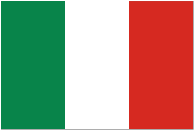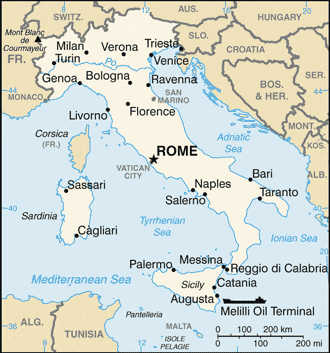Table of Contents
| Location and Size | Credit and Collections |
| Government | Risk Assessment |
| Legal System | Business Climate |
| People | Business Protocol |
| Economy | |
| Comparative Indicators |
12345
Location and Size
Italy is located in southern Europe. It is a peninsula extending into the central Mediterranean Sea, northeast of Tunisia. The total area is 301,340 sq. km, slightly larger than Arizona.
Government
Italy has been a democratic republic since June 2, 1946, when the monarchy was abolished by popular referendum. The Italian state is centralized. The prefect of each of the provinces is appointed by and answerable to the central government. In addition to the provinces, the constitution provides for 20 regions with limited governing powers.
The 1948 constitution established a bicameral parliament (Chamber of Deputies and Senate), a separate judiciary, and an executive branch composed of a Council of Ministers (cabinet), President Sergio Mattarella (head of state) and the Prime Minister Giorgia Meloni (head of government). The houses of parliament are popularly and directly elected by a proportional representation system.
Legal System
Italy’s legal system is based on civil law. Italy has not accepted compulsory International Court of Justice (ICJ) jurisdiction.
People
- Population: 60,220,776 (2023 est.)
- Population growth rate: .06% (2023)
- Languages: Italian 97.41%, other languages: English, French, and Spanish
- Literacy: 99.94% (2023 est.)
- Ethnic Make-up: Italian 95%, Albanians, Romanians, Ukrainians, and other Europeans (2.5%); Africans (1.5%), and several other minorities (1%) (2023 est.)
- Religions: Christian 85.6% (predominantly Roman Catholic), Protestants 0.6%, unspecified 1.5%, 7.5% atheists, 4.2% agnostics (2023 est.)
Economy
The Italian economy has changed dramatically since the end of World War II. From an agriculturally based economy, it has developed into an industrial state ranked as the world’s seventh-largest market economy.
Italy has a diversified industrial economy, which is divided into a developed industrial north, dominated by private companies, and a less-developed, welfare-dependent, agricultural south, with high unemployment. The Italian economy is driven in large part by the manufacture of high-quality consumer goods produced by small and medium-sized enterprises.
Italy is the fourth largest European economy and has for long enjoyed one of the highest per-capita incomes in Europe, despite the decline in traditional industries such as textiles and car manufacturing as a result of globalization.
Italy belongs to the Group of Eight (G-8) industrialized nations, is a member of the European Union (EU) and the Organization for Economic Cooperation and Development (OECD).
Leading Markets (2023): Germany 12.5%, France 10.3%, US 9%, Spain 5.2%, UK 5.2%, Switzerland 4.6%
Leading Exports – Commodities: Engineering products, textiles and clothing, production machinery, motor vehicles, transport equipment, chemicals; food, beverages and tobacco; minerals, and nonferrous metals.
Leading Suppliers (2023): Germany 16.3%, France 8.8%, China 7.1%, Netherlands 5.6%, Spain 5.3%, Belgium 4.5%
Leading Imports – Commodities: Engineering products, chemicals, transport equipment, energy products, minerals and nonferrous metals, textiles and clothing; food, beverages, and tobacco.
Top Industries: Tourism, machinery, iron and steel, chemicals, food processing, textiles, motor vehicles, clothing, footwear, ceramics.
Top Agricultural Products: Fruits, vegetables, grapes, potatoes, sugar beets, soybeans, grain, olives; beef, dairy products; fish.
Comparative Economic Indicators – 2023
| Italy | Austria | France | Slovenia | Switzerland | USA | |
| Population (millions) | 60.22 | 8.474 | 66.03 | 2.0 | 7.6 | 331.9 |
| Population growth rate (%) | 0.6 | 0.5 | 0.5 | -0.142 | 0.223 | 0.1 |
| Literacy (%) | 99.94 | 99.0 | 99.0 | 99.7 | 99.0 | 99.0 |
| Unemployment rate (%) | 7.9 | 1 | 9.7 | 9.4 | 4.4 | 3.5 |
| Inflation (%) | 9.8 | 1.2 | 0.1 | 0.8 | 0.1 | 2.1 |
| Population below poverty line (%) | 37.9 | 4.2 | 6.2 | 12.3 | 7.4 | 15.1 |
| GDP** (USD billions) | 35,925.88 | 50,546.70 | 2,110.0 | 55.8 | 317.0 | 23,320.0 |
| GDP real growth rate (%) | -1.9 | 0.4 | -2.2 | -7.3 | -1.5 | 2.2 |
| GDP per capita (USD) | 28,484.35 | 50,546.0 | 32,800.0 | 27,900.0 | 41,700.0 | 53,041.0 |
| Public debt (% of GDP) | 132.6 | 74.5 | 79.7 | 34.0 | 43.5 | 78.8 |
| Exports (USD billions) | 369.0 | 141.4 | 546.8 | 24.3 | 190.1 | 1,553.0 |
| Imports (USD billions) | 358.7 | 139.8 | 532.2 | 22.9 | 177.2 | 2,361.0 |
| Currency | Euro EUR |
Euro EUR |
Euro EUR |
Euro EUR |
Euro EUR |
Dollar
USD |
| Exchange rates (per USD) 3/23/2023 | 1.08 | 1.12 | 0.8 | 0.8 | 0.8 | n/a |
| Exchange rates (per EUR) 03/23/2023 | n/a | n/a | n/a | n/a | n/a | 1.08 |
Economic Data from CIA World Factbook
Credit and Collections
Dispute Resolution
Italy has a written and consistently applied commercial and bankruptcy law. Foreign creditors can choose among different means of dispute resolution, including legally binding arbitration. However, Italian courts accept and enforce foreign and arbitral panel judgments only upon request, which puts the issue back into the Italian judiciary.
Though notoriously slow (civil trials average seven years in length), the Italian legal system meets generally recognized principles of international law, with provisions for enforcing property and contractual rights. Creditors should be aware, however, that the Italian legal system does not have some of the basic protections found in U.S and other European countries. For instance, jury members are selected at random but are not vetted for prejudices nor are they sequestered during trials.
Risk Assessment
Coface Country Rating: B – Moderate risk.
Coface Business Climate Rating: A2 – Relatively low risk.
After negotiating key partnerships with Algeria and Azerbaijan, among others, Italy has strongly reduced its dependence on Russian gas to 10% of total gas imports (from a pre-war level of 40%). However, these diversified supply sources have been secured at very high prices. Hence, inflationary pressures have continued to intensify and should only moderate gradually in 2023. Italian companies are therefore facing increased cost pressures, lower margins, and increased uncertainty, all of which will take a toll on capital investment.
Business Climate
According to the World Bank, Italy is a country with high freedom for business, investment and trade. The Italian economy is well developed and surpasses that of the United Kingdom, Germany and Greece.
Italy has moved slowly on implementing needed structural reforms, however, such as reducing political corruption, overhauling costly entitlement programs, and increasing employment opportunities for young workers, particularly women. These conditions will be exacerbated in the near-term by the global economic downturn. In the longer-term, Italy’s low fertility rate and quota-driven immigration policies will increasingly strain its economy.
Transparency of Regulatory System: Italy is subject to single market directives mandated by the EU, which are intended to harmonize regulatory regimes among EU countries. In reality, the average firm in Italy faces an uphill climb as regards compliance with business regulations.
Intellectual Property Rights: Inadequate enforcement of Intellectual Property Rights (IPR) remains a serious problem in Italy. While anti-piracy and anti-counterfeiting laws on the books are widely regarded as adequate, relatively few IPR cases are brought to trial. Judges still regard IPR violations (and copyright violations in particular) as petty offenses, and they are a weak link in combating piracy in Italy.
Conversion and Transfer Policies: In accordance with EU directives, Italy has no foreign exchange controls. There are reporting requirements but no restrictions on currency transfers.
Economic Freedom: Italy’s economic freedom score is 62.3, making its economy the 69th freest in the 2023 Index of Economic Freedom. Italy is ranked 36th out of 44 countries in the Europe region, and its score is slightly above the world average.
Corruption: Corruption and organized crime are significant impediments to investment and economic growth in Italy. Transparency International’s Corruption Perceptions Index 2018 ranked Italy 53rd out of 180 countries evaluated, receiving an overall score of 52 out of 100.
Political Violence: Political violence is not a threat to foreign investments in Italy.
Business Protocol
Italians prefer to do business with people they know and trust. A third party introduction will go a long way in providing an initial platform from which to work. Italians much prefer face-to-face contact, so it is important to spend time in Italy developing the relationship.
**********
Subscribe to the Credit-to-Cash Advisor
Monthly e-Newsletter — It’s Free
This information is provided by ABC-Amega Inc. Providing international receivable management and debt collection services for exporters to more than 200 countries. For further information, contact info@abc-amega.com.

